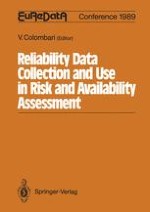1989 | OriginalPaper | Buchkapitel
Physics Models for Reliability Data Processing
verfasst von : R. Righini, G. Zappellini
Erschienen in: Reliability Data Collection and Use in Risk and Availability Assessment
Verlag: Springer Berlin Heidelberg
Enthalten in: Professional Book Archive
Aktivieren Sie unsere intelligente Suche, um passende Fachinhalte oder Patente zu finden.
Wählen Sie Textabschnitte aus um mit Künstlicher Intelligenz passenden Patente zu finden. powered by
Markieren Sie Textabschnitte, um KI-gestützt weitere passende Inhalte zu finden. powered by
Normally, in examining and processing failure reliability data, people apply the flat part of the “bathtube” curve; experience has verified that for many simple electric and electronic components such a distribution occurs: they are characterized by a long period with few and random failures. But experience has also verified that many types of components have not a constant hazard rate; f. e., normally mechanical components have a wearout characteristic and a continuously increasing hazard rate during all the life. Besides, if only two or three items are tested for a short time, little in the way of accurate quantitative conclusions can be drawn applying the classical statistics laws and assuming a bathtube distribution; bayesian methods may be taken into consideration, but these methods may be applied only when significative data on a set of similar items (components) is available; on the contrary we must remark that the preferred method to compute the reliability of an item is to consider the basic physics of the failure: it is, to predict the component failure rate in terms of a statistical variation of the physics parameters characterizing its operating conditions. On this subject. we must say that if one agrees to characterize a component by a hazard rate function and to evaluate the hazard parameters by testing. the result is a macroscopic model. Such a model is not concerned with what happens inside the black box containing the part but only with the statistics of the part performance. To delve inside the black box. one must postulate various hypotheses about the microscopic behaviour of the device and to prove validity; in this type of reliability model. the causes of the component failure are considered. We have called “physics models” this type of methods to process reliability data; they mainly consist of the following three basic steps: 1-Analysis of the physics laws characterizing the component(part) normal operation.2-Singling out of the parameters of the above laws affected by stocastic variations in order to choose and to define the failure distributions to be applied.3-Evaluation, on the basis of the material data and of the component characteristics. of the limit variation range of the parameters mentioned in point 2 in order to exactly evaluate the foreseen failure rate distribution of the component.ENEA has carried out a data collection on typical components of the French fast reactors Rapsodie and Phenix; these data have been registered on an informatics system. In consideration of the experimental type of these components. of the small number of followed items and of occurred failures. the classical and bayesian methods do not allow the evaluation of too significative reliability data. At this aim ENEA-VEL has set·up some physics models on the ground of the physics laws governing the component operation and of the failure causes. A brief description of these methods, the results obtained by their application on some components and a comparison of these results with the ones obtained applying the classical and bayesian methods will be the subject of the present paper.
